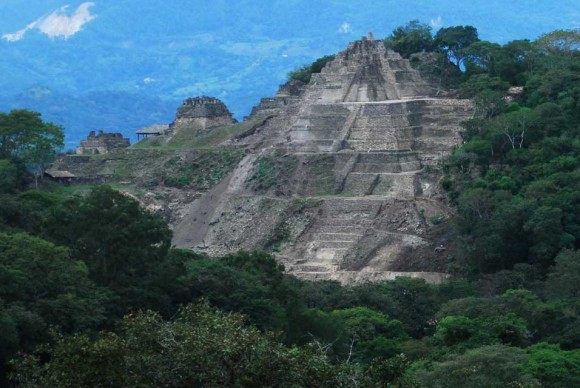Tonina is One of the Greatest Mesoamerican Cities
May 14, 2010 by All Art News
Filed under Antiques & Archaeology
MEXICO CITY.- Restoration and consolidation work conducted by specialists from the National Institute of Anthropology and History (INAH) at the northern part of the Acropolis of Tonina Archaeological Site in Chiapas, have confirmed that it is one of the greatest constructions in Mesoamerica, only comparable to those at Tikal and El Mirador in Guatemala.
Dr. Carlos Pallan Gayol, responsible of the INAH Maya Hieroglyphic and Iconographic Heap (AJIMAYA), who collaborates at the archaeological project at Tonina, announced that the most recent field season at the zone, conducted at the northern area of the Acropolis, presents important advances.
It has been determined that the 75 meters-high section of the Acropolis is integrated by several structures and artificial terraces. As a reference, the Sun Pyramid in Teotihuacan, Estado de Mexico, is 65 meters high.
After INAH acquired adjacent terrains, labors allowed to create a tridimensional map of the northeast sector of this Maya site, confirming that the Prehispanic city is more extended than thought.
“Tonina is bigger than thought. Pyramids are connected by roads located atop nearby elevations, meaning that not just the hill where Acropolis is found was used for constructive purposes.” This is how INAH specialists have determined that urban nucleus has architectural continuity over 10 or 12 hectares, twice the area that corresponds to the southern façade of Acropolis.
“There are pyramids, vaulted structures, huge terraces. From the building provisionally entitled IV Northwest, which is 10 meters high, we have the most elevated point of the conjunct, located in a restricted area. This construction is connected by a great roadway with the Structure I, which until now was considered the tallest of Tonina”.
Along with Dr. Juan Yadeun Angulo, director of Tonina Archaeological Project, Dr. Pallan leaded a group of Postgraduate students from the National School of Anthropology and History (ENAH) in charge of creating the 3D map that registers the northeast structures of the site, their dimensions and road connections.
Epigraphist Pallan, also part of INAH National Coordination of Archaeology, concluded saying that the field season is part of academic instruction of the Tonina Epigraphy and Archaeology Curse, imparted at ENAH by him and Yadeun.

